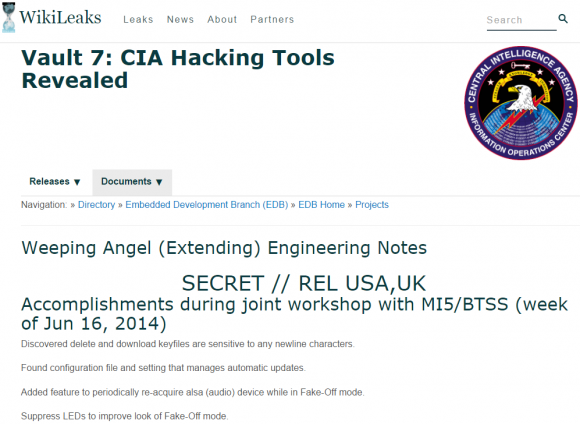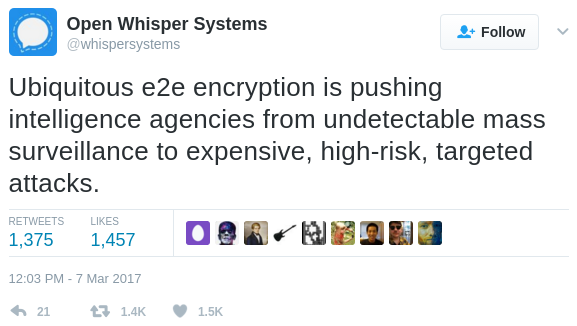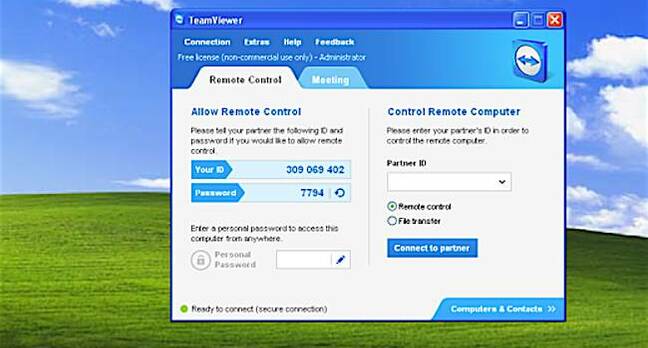WikiLeaks on Tuesday dropped one of its most explosive word bombs ever: A secret trove of documents apparently stolen from the
U.S. Central Intelligence Agency (CIA)
detailing methods of hacking everything from smart phones and TVs to
compromising Internet routers and computers. KrebsOnSecurity is still
digesting much of this fascinating data cache, but here are some first
impressions based on what I’ve seen so far.
First, to quickly recap what happened: In a post on its site, WikiLeaks said the release —
dubbed “Vault 7”
— was the largest-ever publication of confidential documents on the
agency. WikiLeaks is promising a series of these document caches; this
first one includes more than 8,700 files allegedly taken from a
high-security network inside
CIA’s Center for Cyber Intelligence in Langley, Va.

The
home page for the CIA’s “Weeping Angel” project, which sought to
exploit flaws that could turn certain 2013-model Samsung “smart” TVs
into remote listening posts.
“Recently, the CIA lost control of the majority of its hacking
arsenal including malware, viruses, trojans, weaponized ‘zero day’
exploits, malware remote control systems and associated documentation,”
WikiLeaks wrote. “This extraordinary collection, which amounts to more
than several hundred million lines of code, gives its possessor the
entire hacking capacity of the CIA. The archive appears to have been
circulated among former U.S. government hackers and contractors in an
unauthorized manner, one of whom has provided WikiLeaks with portions of
the archive.”
Wikileaks said it was calling attention to the CIA’s global covert
hacking program, its malware arsenal and dozens of weaponized exploits
against “a wide range of U.S. and European company products, includ[ing]
Apple’s iPhone, Google’s Android and Microsoft’s Windows and even
Samsung TVs, which are turned into covert microphones.”
The documents for the most part don’t appear to include the computer
code needed to exploit previously unknown flaws in these products,
although WikiLeaks says those exploits may show up in a future dump.
This collection is probably best thought of as an internal corporate
wiki used by multiple CIA researchers who methodically found and
documented weaknesses in a variety of popular commercial and consumer
electronics.
For example, the data dump lists a number of exploit “modules”
available to compromise various models of consumer routers made by
companies like
Linksys,
Microtik and
Zyxel,
to name a few. CIA researchers also collated several pages worth of
probing and testing weaknesses in business-class devices from
Cisco, whose powerful routers carry a decent portion of the Internet’s traffic on any given day.
Craig Dods, a researcher with Cisco’s rival
Juniper,
delves into greater detail
on the Cisco bugs for anyone interested (Dods says he found no exploits
for Juniper products in the cache, yet). Meanwhile, Cisco has
published its own blog post on the matter.
WHILE MY SMART TV GENTLY WEEPS
Some of the exploits discussed in these leaked CIA documents appear
to reference full-on, remote access vulnerabilities. However, a great
many of the documents I’ve looked at seem to refer to attack concepts or
half-finished exploits that may be limited by very specific
requirements — such as physical access to the targeted device.
The “
Weeping Angel”
project’s page from 2014 is a prime example: It discusses ways to turn certain 2013-model
Samsung
“smart TVs” into remote listening devices; methods for disabling the
LED lights that indicate the TV is on; and suggestions for fixing a
problem with the exploit in which the WiFi interface on the TV is
disabled when the exploit is run.
ToDo / Future Work:
Build a console cable
Turn on or leave WiFi turned on in Fake-Off mode
Parse unencrypted audio collection
Clean-up the file format of saved audio. Add encryption??
According to the documentation, Weeping Angel worked as long as the
target hadn’t upgraded the firmware on the Samsung TVs. It also said the
firmware upgrade eliminated the “current installation method,” which
apparently required the insertion of a booby-trapped USB device into the
TV.
Don’t get me wrong: This is a serious leak of fairly sensitive
information. And I sincerely hope Wikileaks decides to work with
researchers and vendors to coordinate the patching of flaws leveraged by
the as-yet unreleased exploit code archive that apparently accompanies
this documentation from the CIA.
But in reading the media coverage of this leak, one might be led to
believe that even if you are among the small minority of Americans who
have chosen to migrate more of their communications to privacy-enhancing
technologies like
Signal or
WhatsApp, it’s all futility because the CIA can break it anyway.
Perhaps a future cache of documents from this CIA division will
change things on this front, but an admittedly cursory examination of
these documents indicates that the CIA’s methods for weakening the
privacy of these tools all seem to require attackers to first succeed in
deeply subverting the security of the mobile device — either through a
remote-access vulnerability in the underlying operating system or via
physical access to the target’s phone.
As Bloomberg’s tech op-ed writer
Leonid Bershidsky notes,
the documentation released here shows that these attacks are “not about
mass surveillance — something that should bother the vast majority of
internet users — but about monitoring specific targets.”
By way of example, Bershidsky points to
a tweet yesterday from
Open Whisper Systems
(the makers of the Signal private messaging app) which observes that,
“The CIA/Wikileaks story today is about getting malware onto phones,
none of the exploits are in Signal or break Signal Protocol encryption.”
The company went on to say that because more online services are now
using end-to-end encryption to prevent prying eyes from reading
communications that are intercepted in-transit, intelligence agencies
are being pushed “from undetectable mass surveillance to expensive,
high-risk, targeted attacks.”

A tweet from Open Whisper Systems, the makers of the popular mobile privacy app Signal.
As limited as some of these exploits
appear to be, the methodical approach of the countless CIA researchers
who apparently collaborated to unearth these flaws is impressive and
speaks to a key problem with most commercial hardware and software
today: The vast majority of vendors would rather spend the time and
money marketing their products than embark on the costly, frustrating,
time-consuming and continuous process of stress-testing their own
products and working with a range of researchers to find these types of
vulnerabilities before the CIA or other nation-state-level hackers can.
Of course, not every company has a budget of hundreds of millions of dollars just to do basic security research. According to
this NBC News report
from October 2016, the CIA’s Center for Cyber Intelligence (the alleged
source of the documents discussed in this story) has a staff of
hundreds and a budget in the hundreds of millions: Documents leaked by
NSA whistleblower
Edward Snowden indicate the CIA requested $685.4 million for computer network operations in 2013, compared to $1 billion by the
U.S. National Security Agency (NSA).
TURNABOUT IS FAIR PLAY?
NBC also reported that the CIA’s Center for Cyber Intelligence was
tasked by the Obama administration last year to devise cyber attack
strategies in response to Russia’s alleged involvement in the siphoning
of emails from
Democratic National Committee servers as well as from
Hillary Clinton‘s campaign chief
John Podesta. Those emails were ultimately published online by Wikileaks last summer.
the “wide-ranging ‘clandestine’
cyber operation designed to harass and ’embarrass’ the Kremlin
leadership was being lead by the CIA’s Center for Cyber Intelligence.”
Could this attack have been the Kremlin’s response to an action or
actions by the CIA’s cyber center?
NBC reported that
the
“wide-ranging ‘clandestine’ cyber operation designed to harass and
’embarrass’ the Kremlin leadership was being lead by the CIA’s Center
for Cyber Intelligence.” Could this attack have been the Kremlin’s
response to an action or actions by the CIA’s cyber center? Perhaps time (or future leaks) will tell.
Speaking of the NSA, the Wikileaks dump comes hot on the heels of a similar disclosure by
The Shadow Brokers, a hacking group that said it stole malicious software from the
Equation Group, a highly-skilled and advanced threat actor that has been closely tied to the NSA.
What’s interesting is this Wikileaks cache includes
a longish discussion thread
among CIA employees who openly discuss where the NSA erred in allowing
experts to tie the NSA’s coders to malware produced by the Equation
Group. As someone who spends a great deal of time
unmasking cybercriminals who invariably leak their identity and/or location through poor operational security, I was utterly fascinated by this exchange.
BUG BOUNTIES VS BUG STOCKPILES
Many are using this latest deluge from WikiLeaks to reopen the debate
over whether there is enough oversight of the CIA’s hacking
activities.
The New York Times called
yesterday’s WikiLeaks disclosure “the latest coup for the antisecrecy
organization and a serious blow to the CIA, which uses its hacking
abilities to carry out espionage against foreign targets.”
The WikiLeaks scandal also revisits the question of whether the U.S.
government should instead of hoarding and stockpiling vulnerabilities be
more open and transparent about its findings — or at least work
privately with software vendors to get the bugs fixed for the greater
good. After all, these advocates argue, the United States is perhaps the
most technologically-dependent country on Earth: Surely we have the
most to lose when (not if) these exploits get leaked? Wouldn’t it be
better and cheaper if everyone who produced software sought to
crowdsource the hardening of their products?
On that front, my email inbox was positively peppered Tuesday with
emails from organizations that run “bug bounty” programs on behalf of
corporations. These programs seek to discourage the “full disclosure”
approach — e.g., a researcher releasing exploit code for a previously
unknown bug and giving the affected vendor exactly zero days to fix the
problem before the public finds out how to exploit it (hence the term
“zero-day” exploit).
Rather, the bug bounties encourage security researchers to work
closely and discreetly with software vendors to fix security
vulnerabilities — sometimes in exchange for monetary reward and
sometimes just for public recognition.
Casey Ellis, chief executive officer and founder of bug bounty program
Bugcrowd,
suggested the CIA WikiLeaks disclosure will help criminal groups and
other adversaries, while leaving security teams scrambling.
“In this mix there are the targeted vendors who, before today, were
likely unaware of the specific vulnerabilities these exploits were
targeting,” Ellis said. “Right now, the security teams are pulling apart
the Wikileaks dump, performing technical analysis, assessing and
prioritizing the risk to their products and the people who use them, and
instructing the engineering teams towards creating patches. The net
outcome over the long-term is actually a good thing for Internet
security — the vulnerabilities that were exploited by these tools will
be patched, and the risk to consumers reduced as a result — but for now
we are entering yet another Shadow Brokers, Stuxnet, Flame, Duqu, etc., a
period of actively exploitable 0-day bouncing around in the wild.”
Ellis said that — in an ironic way, one could say that Wikileaks, the
CIA, and the original exploit authors “have combined to provide the
same knowledge as the ‘good old days’ of full disclosure — but with far
less control and a great many more side-effects than if the vendors were
to take the initiative themselves.”
“This, in part, is why the full disclosure approach evolved into the coordinated disclosure and
bug bounty
models becoming commonplace today,” Ellis said in a written statement.
“Stories like that of Wikileaks today are less and less surprising and
to some extent are starting to be normalized. It’s only when the pain of
doing nothing exceeds the pain of change that the majority of
organizations will shift to an proactive vulnerability discovery
strategy and the vulnerabilities exploited by these toolkits — and the
risk those vulnerabilities create for the Internet — will become less
and less common.”
Many observers — including a number of cybersecurity professional
friends of mine — have become somewhat inured to these disclosures, and
argue that this is exactly the sort of thing you might expect an agency
like the CIA to be doing day in and day out.
Omer Schneider, CEO at a startup called
CyberX, seems to fall into this camp.
“The main issue here is not that the CIA has its own hacking tools or
has a cache of zero-day exploits,” Schneider said. “Most nation-states
have similar hacking tools, and they’re being used all the time. What’s
surprising is that the general public is still shocked by stories like
these. Regardless of the motives for publishing this, our concern is
that Vault7 makes it even easier for a crop of new cyber-actors get in
the game.”

 TalkTalk has
blocked remote desktop management tool TeamViewer from its network,
following a spate of scammers using the software to defraud customers.
TalkTalk has
blocked remote desktop management tool TeamViewer from its network,
following a spate of scammers using the software to defraud customers.










